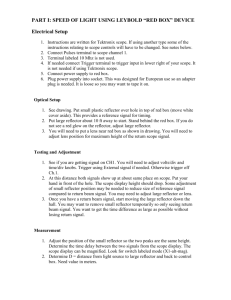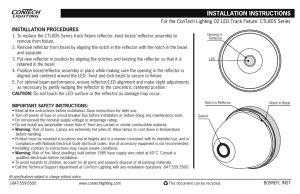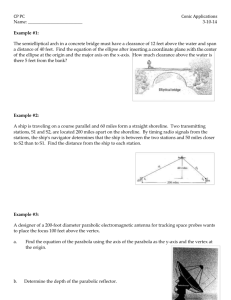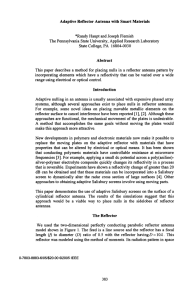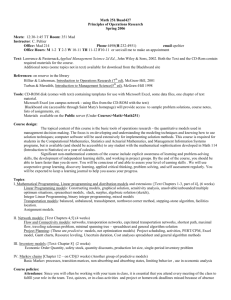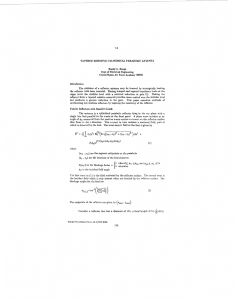Near Field Nulling with a Cylindrical Reflector and Moving Plates
advertisement
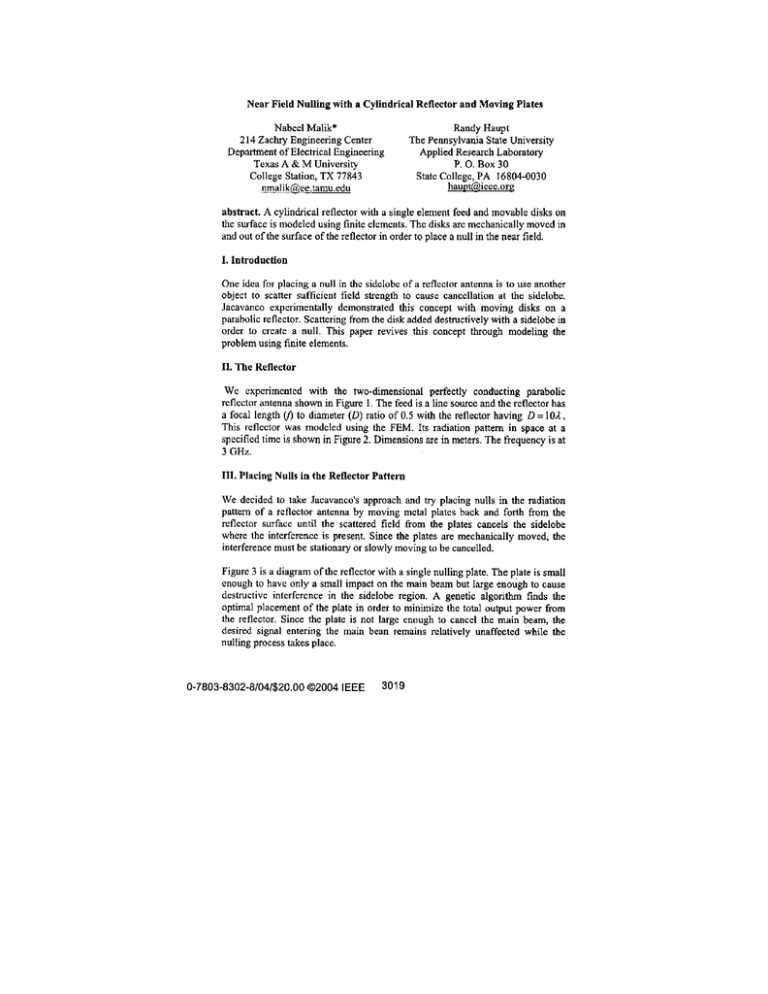
Near Field Nulling with a Cylindrical Reflector and Moving Plates Nabeel Malik' 214 Zachry Engineering Center Department of Electrical Engineering Texas A & M University College Station, TX 77843 nmalik@ee.tamu.edu Randy Haupt The Pennsylvania State University Applied Research Laboratory P. 0. Box 30 State College, PA 16804-0030 hauot@ieee.org abstract. A cylindrical reflector with a single element feed and movable disks on the surface is modeled using finite elements. The disks are mechanically moved in and out of the surface of the reflector in order to place a null in the near field. I. Introduction One idca for placing a null in the sidelobe of a reflector antenna is to use another object to scatter sufficient field strength to cause cancellation at the sidelobe. Jacavanco experimentally demonstrated this concept with moving disks on a parabolic reflector. Scattering from the disk added deshuctively with a sidelohe in order to create a null. This paper revives this concept through modeling the problem using finite elements. 11. The Reflector We experimented with the two-dimensional perfectly conducting parabolic reflector antenna shown in Figure 1. The feed is a line source and the reflector has ratio of 0.5 with the reflector having D = 101. a focal length v) to diameter (0) This reflector was modeled using the FEM. Its radiation panem in space at a specified time is shown in Figure 2. Dimensions are in meters. The frequency is at 3 GHz. 111. Placing Nulls in the Reflector Pattern We decided to take Jacavanco's approach and try placing nulls in the radiation pattem of a reflector antenna by moving metal plates back and forth from the reflector surface until the scattered field from the plates cancels the sidelobe where the interference is present. Since the plates are mechanically moved, the interference must be stationw or slowly moving to be cancelled. Figure 3 is a diagram of the reflector with a single nulling plate. The plate is small enough to have only a small impact on the main beam but large enough to cause destmctive interference in the sidelobe region. A genetic algorithm finds the optimal placement of the plate in order to minimize the total output power from the reflector. Since the plate is not large enough to cancel the main beam, the desired signal entering the main bean remains relatively unaffected while the nulling process takes place. 0-7803-8302-8/04/$20.00 02004 IEEE 3019 Meters f = Frequency (3GHz) wn D=IOX ofthe -0,4 ~ Reflectar . - Note: Firmre Not Drawn to Scale i 0.075 0.575 Meters Figure 1 . Geometry o f the parabolic reflector. 0.'' 2.5 XI 1 0.5 .o . -0.5 -2.5 Figure 2. E-field panern at 3 GAz from a point source (U10 in size) at the focal point ofthe reflector (Xand Y in meters and Elechic Field Intensity in V h ) . 3020 Meters Flat Metal Plate nt of the Reflector . . 0.075 6.11 5.35 Note: Fimre Not Drawn to Scale - 0.575 --* Meters Figure 3. Schematic diagram of flat metal plate of size h moving at y = 0.2m. 1 0.8 . . 0.6 0.4 0.2 y o -0.2 -0.4 i0.6 6.8 .,-'1 Figure 4. Electric field pattems in presence of a flat metal plate of size h with null at ( I , 0.7) (X and Y in meters and Electric Field Intensity in V h ) . 3021 TABLE 1 COMPARISON BETWEEN TWO DIFFERENT VERTICAL POSITIONS OF THE FLAT METAL PLATE (dB REDUCTION) IV. Results We tried three different sized metal plates each at two different vertical positions. A genetic algorithm (CA) was used to move the plate to find the greatest amount of sidelohe reduction. Table 1 shows the dB reduction for each size and vertical position. The amount of reduction was found to be directly proportional to the size of the metal plate regardless of its vertical position. This conforms to the fact that as the surface area of the plates is increased, we get more control over the scattered field and thus get more reduction at the desired location where the interference is present. In general, the plate closest to the axis provides the most sidelobe level reduction. It also causes the greatest amount of main beam distortion. V. Conclusions A plate can he mechanically moved on the reflector surface to create a null in a sidelobe. The size of the plate is chosen such that the scattered field is large enough to cancel the sidelohe but small enough to cause minimal distortion to the main beam. Bibliography [I] D. Jacavanco, "Reflector antenna having sidelohe suppression elements," US. Patent4,631,547, Dec 23, 1986. 3022

